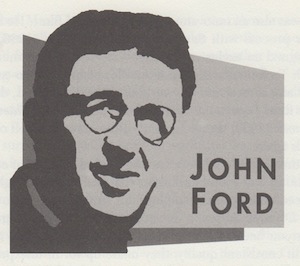
Born: February 1, 1895, Cape Elizabeth, ME
Died: August 31, 1973, Palm Desert, CA
He kept calling me a clumsy bastard and a big oaf and kept telling me that I moved like an ox.
—John Wayne
In 1914, director Francis Ford encouraged his younger brother to leave home for Hollywood. John (“Jack”) Ford got work as an extra, playing a hooded Ku Klux Klan member on horseback in D.W. Griffith’s The Birth of a Nation (1915) before working his way onto the production crew, first as a propman and soon as second director on serial westerns. Cashing in on Francis’s success, John Ford landed a position at the William Fox studio, in 1921.
Now a full-fledged director, he created silent western epics, including The Iron Horse (1924), and became well known for his skill at telling a story straight. Ford’s early films may have settled the West, but the westerns he made after World War II added depth to the genre. His breakthrough Stagecoach (1939) was the most influential western made since Edwin S. Porter’s The Great Train Robbery (1903). The shining performance of a handsome young John Wayne was complemented by a remarkable cast of character actors. Along with the daring stunt work of Yakima Canutt, the film presented horse falls and stagecoach leaps that had never before been captured on film; this facet of Stagecoach alone raised the bar for serial action pictures. The final sequence, an Indian attack, was a masterstroke of tension and timing that became the template for climactic horseback battles in all westerns that followed. Stagecoach has been referred to as the greatest all-around western ever, a milestone in American film and in the genre itself.
Ford also got the chance to film back home in Ireland, making The Informer (1935) and The Quiet Man (1952), both Oscar winners. But it was on American soil with American subjects that Ford built his reputation, illuminating the country’s most cherished values in such dramas as Young Mr. Lincoln (1939) and The Grapes of Wrath (1940).
My Darling Clementine (1946) revealed a darker side of Ford’s work and required a nastier turn from Henry Fonda, a member of Ford’s stock troupe of performers. The stark, isolated story of a famous shootout was filmed against the landscapes of Monument Valley, a favorite Ford location. The Arizona desert would become his personal playground, and his best work is remembered for the towering pillars of red rock as much as for the spectacular open-space vistas. The romantic feeling of his films owes much to the untouched beauty of these settings.
Ford’s traditional values and sentimental stories were best suited for actors like Fonda, Jimmy Stewart, Ward Bond and Ben Johnson, but it was Wayne who became most closely associated with the Ford western after the war. Their collaboration on She Wore a Yellow Ribbon (1949) was accentuated by the special Technicolor hues developed especially for Ford by Natalie Kalmus. The film set the look and feel of the modern western in the age of color films. Wayne and Ford also blazed trails in the genre with Fort Apache (1948) and Rio Grande (1950). These films, often referred to as a trilogy, helped define the code of the cowboy that Wayne embodied best.
Most critics consider Ford’s The Searchers (1956) the darkest western ever made—a Wayne vehicle that rubbed the luster from cowboy stories. It was followed by The Man Who Shot Liberty Valance (1962), shot in black and white. These two films showed that Ford was unafraid to erase the good-versus-evil stereotypes and challenge the notions of heroism. They represented the last of his films with the “Duke” character, an icon he had spent fifty years molding. After his final western, Cheyenne Autumn (1964), Ford saddled up and rode off into retirement.
Technically and ideologically, all westerns are framed by John Ford’s influence. As a man who shunned introspective discussion about technique or meaning in his films, Ford had a no-nonsense manner that was reflected on the screen in the simple, consistent choices he made as a director. This shoot-from-the-hip attitude rubbed off on the productions, and soon the genre had become an extension of the man. In this way, John Ford was to westerns what Alfred Hitchcock was to suspense films.
To read all the republished articles from ‘The Film 100,’ go to Reintroducing the Film 100 here on Keyframe.




